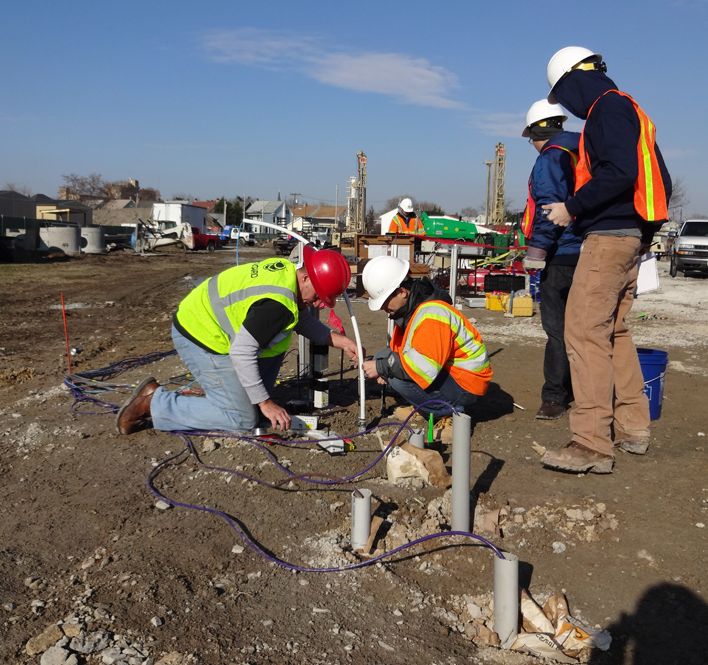Comprehensive Geotechnical Works to Ensure Site Stability
Wiki Article
How Consulting Engineers Enhance Geotechnical Engineering Projects: Insights Into Their Knowledge, Methods, and Collaborative Approaches
Consulting designers are crucial in enhancing geotechnical engineering projects, applying their specialized knowledge to browse the complexities of subsurface conditions. Their methods incorporate an array of site investigation techniques, consisting of Criterion Penetration Tests (SPT) and Cone Penetration Examinations (CPT), which educate essential choices during the design and construction phases. Furthermore, their joint strategies foster interaction among diverse task stakeholders, eventually shaping the task's trajectory. As we examine the multifaceted duties these specialists play, it ends up being clear that their contributions prolong beyond technological competence, motivating a better take a look at the implications for project success.Duty of Consulting Engineers
The know-how of speaking with designers in geotechnical design is fundamental to the successful implementation of building and construction projects. These experts play a crucial function in examining soil and rock buildings, which are critical elements influencing layout and building decisions. By conducting detailed site investigations, consulting engineers accumulate vital information that educates the layout procedure, ensuring jobs are improved secure and ideal ground.Consulting designers also provide vital understandings right into threat monitoring (geotechnical geologist). They recognize possible geotechnical hazards, such as landslides, soil liquefaction, and settlement issues, enabling stakeholders to implement effective mitigation techniques. Their know-how help in enhancing foundation designs, which can result in considerable cost savings and boosted safety and security
In addition, seeking advice from designers work as an important link in between task proprietors, engineers, and service providers. Their capability to translate complex geotechnical information into actionable suggestions fosters cooperation and assists in informed decision-making throughout the task lifecycle. This multidisciplinary method not just boosts project efficiency yet also ensures conformity with regulatory criteria and best methods.
Key Techniques in Geotechnical Engineering

One key technique is website examination, which entails performing area examinations and research laboratory evaluations to collect data on subsurface conditions. Techniques such as Standard Infiltration Screening (SPT) and Cone Infiltration Screening (CPT) are commonly used to evaluate dirt stratigraphy and toughness. In addition, geophysical techniques, including seismic and electrical resistivity studies, provide non-invasive means to analyze subsurface characteristics.
An additional essential technique is mathematical modeling, which allows engineers to simulate numerous situations and predict just how soil-structure interactions will certainly act under different loading problems. Finite Element Evaluation (FEA) is a common technique utilized in this context.
In addition, the design of structures, maintaining structures, and earthworks counts greatly on these methodologies - geotechnical geologist. By incorporating sophisticated logical tools with area data, getting in touch with designers can create tailored services that address certain task difficulties, inevitably contributing to the security and security of building tasks
Importance of Dirt Evaluation
Dirt evaluation acts as a foundational aspect in geotechnical design, offering crucial insights into the physical and chemical properties of soil required for efficient construction planning. Comprehending soil attributes is crucial for establishing its load-bearing capacity, drainage habits, and possibility for negotiation or instability. Detailed dirt examinations, consisting of tasting and research laboratory screening, aid recognize criteria such as soil type, wetness material, density, and shear strength.
These analyses notify the selection of suitable construction strategies and products, eventually affecting task safety and security and durability. Cohesive soils might need different structure styles compared to granular soils, demanding tailored engineering services. Dirt analysis help in determining contaminants that can present threats to human health and wellness or the environment, permitting for the advancement of reduction methods.
Incorporating soil evaluation right into the onset of job growth helps to minimize unpredicted difficulties, guaranteeing that designers can expect and address potential concerns before they intensify. By developing a thorough understanding of the website problems, seeking advice from designers can maximize design effectiveness and lower costs, thus enhancing the total success of geotechnical design projects.
Collaborative Techniques in Tasks
Successful geotechnical jobs frequently pivot on collaborative strategies that combine diverse expertise from various self-controls. Efficient collaboration among seeking advice from designers, rock hounds, ecological researchers, and construction specialists is essential for attending to intricate obstacles and optimizing project end results. By leveraging the distinct skills and understanding of each employee, projects can gain from a holistic understanding of the site problems, governing requirements, and engineering constraints.Regular interaction and interdisciplinary conferences facilitate the sharing of understandings and cultivate advice a culture of synergy. These collaborative initiatives enable the identification of possible threats early in the task lifecycle, allowing for timely mitigation strategies. Moreover, incorporating responses from stakeholders, consisting of regional communities and regulatory firms, makes certain that all point of views are taken into consideration, boosting job approval and conformity.
In addition, the integration of advanced modern technologies, such as Geographic Information Solution (GIS) and Building Details Modeling (BIM), further boosts collaboration. These devices allow for the real-time sharing of data and visualization of geotechnical problems, promoting notified decision-making. Ultimately, a collective approach not only streamlines job implementation but likewise lays the foundation for ingenious services to intricate geotechnical engineering difficulties.
Effect On Project Results

Consulting engineers employ innovative techniques such as threat evaluation and anticipating modeling, which improve the precision of job forecasts. Their capacity to incorporate innovative modern technologies, like geotechnical instrumentation and data analytics, better improves the style and construction procedures. Because of this, tasks experience improved performance, minimized my response expenses, and reduced hold-ups.
Furthermore, cultivating efficient interaction and cooperation among employee improves analytic capabilities. When difficulties emerge, an unified front enables swift identification of remedies, avoiding prospective obstacles. Ultimately, the collective initiatives of speaking with designers add to better outcomes, making sure that tasks meet both regulatory standards and client assumptions.
Final Thought

Report this wiki page